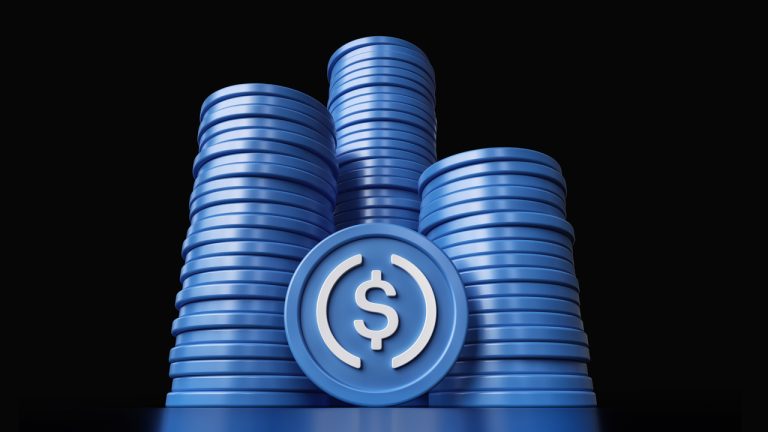
Circle has minted hundreds of millions of dollars worth of US Dollar Coin (UDSC) as the second-largest stablecoin by market cap recovers from its recent depegging from the dollar. USDC, a stablecoin designed to stay pegged to the value of one US dollar, fell in value to as low as $0.87 on March 11 following […]
The post Circle Mints $407,000,000 Worth of USDC as Stablecoin Recovers From Depegging Incident: Nansen appeared first on The Daily Hodl.

Positive developments concerning Circle's $3.3 billion worth of reserves held at Silicon Valley Bank and its new banking partners have seen USDC climb back toward its $1 peg.
Circle’s stablecoin USD Coin (USDC) is climbing back to its $1 peg following confirmation from CEO Jeremy Allaire that its reserves are safe and the firm has new banking partners lined up at “banking open tomorrow morning.”
According to CoinGecko data, USDC is up 3.3% over the past 24 hours to sit at $0.99 at the time of writing.
The price dropped to as low as $0.87 over the weekend amid concerns about $3.3 billion worth of USDC reserves being held at Silicon Valley Bank (SVB), which was shut down by the California Department of Financial Protection and Innovation on Mar. 10.
Circle also has an undisclosed amount of reserves stuck at the recently bankrupted Silvergate.
In a March 12 Twitter thread, Allaire praised the U.S. government and Federal Reserve for its $25 billion funding program to support liquidity-troubled banks such as SVB:
“100% of USDC reserves are also safe and secure, and we will complete our transfer for remaining SVB cash to BNY Mellon. As previously shared, liquidity operations for USDC will resume at banking open tomorrow morning.”
Update thread on USDC
— Jeremy Allaire (@jerallaire) March 12, 2023
We were heartened to see the US government and financial regulators take crucial steps to mitigate risks extending from the fractional banking system.
100% of deposits from SVB are secure and will be available at banking open tomorrow.
Allaire added that following the implosion of crypto-friendly Signature Bank on Mar. 12, Circle is no longer able to process USDC minting and redemption through SigNet, and that the firm will be temporarily “relying on settlements through BNY Mellon.”

Several USD Coin holders have fled to other stablecoins amid fears surrounding its solvency.
Several USD Coin (USDC) holders have fled to other stablecoins since March 10 amid fears surrounding its solvency following the disclosure that a small portion of USDC's collateral was held at Silicon Valley Bank.
However, not all of them had success during panic selling. One user paid over 2,000,000 USDC to receive $0.05 of Tether (USDT) by dumping a large amount of 3CRV (DAI/USDC/USDT) into USDT.
KyberSwap aggregation router was used in the transaction. Kyberswap is a decentralized exchange (DEX) that aggregates liquidity from several DEXs. In a postmortem, the protocol team explained that "since the market was undergoing a volatile period, all routes failed at estimating gas. The rate strongly fluctuated & only 0x’s route was successful but with a very poor rate."
After confirming the swap at 0x's rate in a pop-up, a bot detected the opportunity and gained 2,085,256 USDC from that Univ2 pool. The protocol is in talks with the bot creator, the bot user and third parties to assist with funds recovery.
Also moving funds to other stablecoins, Tron founder Justin Sun reportedly withdrew 82 million USDC using the decentralized finance protocol Aave v2 and swapped it for Dai (DAI), worth nearly $75 million.
Wallets related to IOSG Ventures sold 118.73 million USDC for 105.67 million USDT, as well as 2,756 Ether (ETH) worth $3.98 million via three addresses, on-chain data shows. The institution still holds nearly 45 million in USDC.
Curve 3pool share is the bellwether of crypto sentiment
— Panda Jackson (@pandajackson42) March 11, 2023
During today's USDC depeg, ppl panic sold USDC & DAI for USDT. USDT share in 3pool collapsed to 2%
Ironically, when Tether FUD happened during Terra crash & FTX collapse, USDT was the "infamous" & left 85% in 3pool pic.twitter.com/VNo3ykxiob
The USDC price is slowly recovering after turbulent trading hours on March 11 to trade at $0.97 at the time of publication.
Circle, the company behind the USDC, disclosed holding $3.3 billion at the Silicon Valley Bank, nearly 23% of its reserves. The bank was shut down by California authorities on March 10 after disclosing efforts to raise extra capital.
Circle said in a recent statement that USDC liquidity operations will "resume as normal when banks open on Monday morning in the United States," enabling USDC redemption at 1:1 with the U.S. dollar.

According to Circle, USDC liquidity operations will "resume as normal when banks open on Monday morning in the United States," enabling USDC redemption at 1:1 with the U.S. dollar.
USD Coin (USDC) issuer Circle plans to use "corporate resources" to cover the shortfall on its reserves following Silicon Valley Bank's shutdown, said the company in a statement on March 11.
According to Circle, USDC liquidity operations will "resume as normal when banks open on Monday morning in the United States," enabling USDC redemption at 1:1 with the U.S. dollar.
The announcement came after the stablecoin lost its $1 peg on March 11 to trade as low as $0.87 before slowly re-pegging at $0.98 at the time of publication. The stablecoin lost its peg after the disclosure of $3.3 billion of Circle's reserve at Silicon Valley Bank.

Silicon Valley is one of the biggest lenders in the United States and a major player for venture-backed companies. The bank was shut down on March 10 by the California Department of Financial Protection and Innovation, fueling fears about its future. The Federal Deposit Insurance Corporation was appointed as the receiver to protect insured deposits.
Sharing an Update on USDC and Silicon Valley Bank. https://t.co/Ug3qpot8sJ
— Jeremy Allaire (@jerallaire) March 11, 2023
In the statement, Circle asserted that Silicon Valley is "a venerable and trusted partner to the US innovation economy," which suffered a "classic bank run, much like those we saw during the financial crisis in 2008. Few traditional banks have sufficient liquidity to withstand such a run."
SVB suffered significant losses which led to a situation where they were forced to sell long-duration assets to meet redemption demand. The settlement period on these assets caused a short-term liquidity crunch, leading to the FDIC stepping in to administer the bank yesterday. SVB’s fate is being decided this weekend by the FDIC and it's our hope that they will find a solution that protects customers’ assets 100%.
USDC is the second-biggest stablecoin, with a market cap of over $42 billion as of January 31, serving as collateral for many stablecoin ecosystems. Its depeg had an immediate effect on other stablecoin ecosystems, Cointelegraph reported earlier today.
Relief efforts are underway less than 72 hours after the collapse of American tech bank Silicon Valley Bank (SVB), Cointelegraph reported. According to Bob Elliot, chief investment officer of Unlimited Funds, "big banks actively working on buying svb business." The U.S. Federal Deposit Insurance Corporation (FDIC) will cover 95% of uninsured deposits to the acquirer, and that "50pct of uninsured paid out next week."
According to Circle's latest audit report from January, USDC is 100% backed by cash and U.S. Treasuries, with nearly $8.6 billion held by U.S. banks as of Jan. 31, representing roughly 20% of its reserves. Another $33 billion of its reserves are held in U.S Treasurys managed by BlackRock through the Circle Reserve Fund, registered as a government money market fund and custody by BNY Mellon. Circle’s January report was reviewed and certified by Big Four accounting firm Deloitte.

Circle CEO Jeremy Allaire is speaking out for the first time following USDC‘s depeg from the dollar, which saw over $6.3 billion disappear from the second-largest stablecoin’s market cap. In a new company update also posted to Twitter, Allaire says that USDC is still redeemable for dollars on a 1 for 1 basis. USDC lost […]
The post Jeremy Allaire Says Circle Will Use Own Resources to Cover Shortfalls As USDC Moves Closer to Peg appeared first on The Daily Hodl.

The trading freeze follows an analysis from DeFi's risk manager firm Gauntlet Network considering different scenarios for the USD Coin price.
Lending protocol Aave has frozen stablecoins trading and set Loan-to-Value (LTV) ratio to zero in response to recent price volatility on stablecoins after the USD Coin (USDC) depegged on March 11.
According to the Aave's governance forum, the trading freeze follows an analysis from DeFi's risk manager company Gauntlet, recommending that all V2 and V3 markets should be temporarily paused.
"Setting LTV to 0 definitely helps everywhere, but on the Avalanche v3 Pool, given that cross-chain infrastructure doesn’t cover Avalanche, the Aave Guardian can act immediately. Setting LTV to 0 in practise discounts the “borrowing power” of the asset, without affecting the HF of any user position," noted one participant in the forum discussion.
LTV is an important metric that determines how much credit you can secure using crypto as collateral. Expressed as a percentage, the ratio is calculated by dividing the amount of credit borrowed by the value of collateral.
Gauntlet's risk analysis examined the amount of insolvencies that might occur under different scenarios, considering that the price of USDC stabilizes, recovers, or declines significantly:
"V3 emode assumes correlation of stablecoin assets, but at this time, those correlations have diverged. The risk has increased given that the liquidation bonus is only 1% for USDC on emode. To account for these assumptions that no longer remain true, we recommend pausing the markets. [...] At current prices, insolvencies are ~550k. These can change depending on the price trajectory and further depegs."

Centralized crypto exchanges have seen a surge in trading volume in the past hours following the Silicon Valley Bank (SVB) collapse on March 10, according to digital assets data provider Kaiko.
Two big $USDC markets on exchanges seeing heavy sell pressure and huge volumes in last 24 hours
— Conor Ryder (@ConorRyder) March 11, 2023
Despite plenty of reassurance on crypto twitter, most investors still selling USDC at a big discount pic.twitter.com/W9uy2HHax4
Silicon Valley Bank was shut down by the California Department of Financial Protection and Innovation on March 11 after bank run triggered by the banks latest financial reports showing it had sold a large chunk of securities worth $21 billion at the time of sale, at a loss of about $1.8 billion. The California watchdog also appointed the Federal Deposit Insurance Corporation (FDIC) as the receiver to protect insured deposits.
Circle, the company behind the USDC, disclosed on March 11 that $3.3 billion of its $40 billion reserves were stuck at SBV, leading the major stablecoin price to fall below its $1 peg and affecting many stablecoin ecosystems as a result.

The USD Coin depeg led the DeFi protocol to experience a record-breaking daily trading volume as crypto whales fight for assets.
Stablecoin swapping pool Curve Finance is experiencing the highest daily trading volume in its history, exceeding $7 billion in the past 24 hours after the Silicon Valley Bank (SVB) collapse triggered a wave of uncertainty across markets and depegged the USD Coin (USDC) from the U.S. dollar.
Looks like we have the biggest daily trading volume in history
— Curve Finance (@CurveFinance) March 11, 2023
Curve supports liquidity pools for major stablecoins, such as USDC, Tether (USDT), Frax (FRAX), Dai (DAI) and TrueUSD (TUSD). Fear, doubt, and uncertainty have spread across crypto markets during the last few hours, resulting in unbalanced pools in the DeFi platform due to a sell-off of USDC, leading the major stablecoin price to fall below its $1 peg.
USDC is the second-biggest stablecoin, with a market cap of over $42 billion as of January 31, serving as collateral for many stablecoin ecosystems. Its depeg had an immediate effect on other stablecoins like DAI issued by MakerDAO, down 5% at the time of publication.
To prevent panic selling, MakerDAO filed an “urgent executive proposal to mitigate risks to the protocol” on March 11 seeking restrictions on minting DAI using USDC. MakerDAO is one of the largest holders of the stablecoin, with over 3.1 billion USDC ($2.85 billion) in reserves collateralizing DAI. Crypto whales have reported severe losses and appear to be fleeing their assets in an attempt to preserve capital, Cointelegraph reported.
Circle, the company behind the USDC, disclosed on March 11 that $3.3 billion of its $40 billion reserves were stuck in the Silicon Valley Bank, which was shut down the day before by the California Department of Financial Protection and Innovation. The watchdog also appointed the Federal Deposit Insurance Corporation (FDIC) as the receiver to protect insured deposits.
Silicon Valley Bank is one of six banking partners Circle uses for managing the ~25% portion of USDC reserves held in cash. While we await clarity on how the FDIC receivership of SVB will impact its depositors, Circle & USDC continue to operate normally.https://t.co/NU82jnajjY
— Circle (@circle) March 10, 2023
In comments to Cointelegraph, Dave Weisberger, co-founder and CEO of algorithmic-trading platform CoinRoutes, said that the “fodder for a broader contagion event is there” and that “the spark could be materializing,” putting at risk many startups and tech companies in the country — a critical sector for the “sustained growth of the American economy.”

USD Coin (USDC) is struggling to maintain its peg to the US dollar after revelations that some of the cash backing the top stablecoin is stuck in Silicon Valley Bank. The Boston-based firm says $3.3 billion of the $40 billion backing USDC is locked in the collapsed bank, which is now controlled by the FDIC. […]
The post $6,300,000,000 Erased From USDC Market Cap As Top Stablecoin Depegs From US Dollar appeared first on The Daily Hodl.
 On Saturday, March 11, 2023, crypto advocates are concerned as a few stablecoin assets have depegged from their $1 parity. The second-largest stablecoin USDC, issued by Circle Financial, fell below $0.90, reaching a low of $0.877 per coin. Additionally, around five other stablecoins have dropped below the U.S. dollar parity during the early morning (ET) […]
On Saturday, March 11, 2023, crypto advocates are concerned as a few stablecoin assets have depegged from their $1 parity. The second-largest stablecoin USDC, issued by Circle Financial, fell below $0.90, reaching a low of $0.877 per coin. Additionally, around five other stablecoins have dropped below the U.S. dollar parity during the early morning (ET) […]